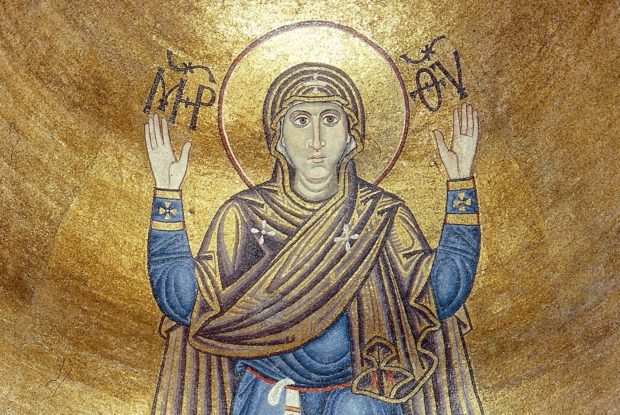- FOKION AVGERINOS – DR. IKE: Athletic Director, Youth Mentor, and Healer
- American Hellenic Institute’s Golden Jubilee Celebration
- Leadership 100 Concludes 33rd Annual Conference in Naples, Florida
- Louie Psihoyos latest doc-series shocks the medical community The Oscar–winning director talks to NEO
- Meet Sam Vartholomeos: Greek-American actor
DEACONESSES: an Orthodox Institution Untheologically Blocked
by Petros Vassiliadis
At the initiative for the Center of Ecumenical, Missiological and Environmental Studies “Metropolitan Penteleimon Papageorgiou” (CEMES), an international scientific symposium on “Deaconesses: Past-Present-Future” was organized in Thessaloniki at the International Hellenic University (IHU), to which its Inter-Orthodox English-speaking Post-graduate Program “Orthodox Ecumenical Theology” belongs. In addition to ΙΗU, four other institutions were registered as co-organizers: The Orthodox Christian Studies Center of Fordham University, St. Philaret’s Christian Orthodox Institute of Moscow, the Orthodox Academy of Crete, and Saint Phoebe Center of Deaconess.
The symposium focused on the Rejuvenation of the Order of Deaconesses with a multi-layer (biblical, liturgical, patristic, archeological, canonical, theological, and historical) analysis, but also with a critical theological assessment of the recent developments in the Orthodox and other churches.
Extremely encouraging were the Messages sent by the Ecumenical Patriarch, the Patriarch of Alexandria, and the Archbishop of Athens.

Expressing his “special joy” and wholeheartedly extending his congratulations “both to those who are responsible for organizing this important symposium, as well as to all its participants,” Ecumenical Patriarch Bartholomew underlined that “the church has never ceased to encourage women to participate in various areas of her multidimensional work and to seek new opportunities and ways of their effective contribution to the life of the Church,” believing “that the effort to rekindle the order of deaconesses must continue, given that even since the time of the Apostles, the deaconesses have greatly contributed to the up building of the faithful, highly honored by them. And this, despite the fact that at times the institution of the ordained deaconesses diminished, though it never formally abolished by the church.” Deaconesses had a “sacramental diaconal priesthood.”
Patriarch of Alexandria Theodoros wrote: “It is an honor and a special blessing the organization of this Symposium on ‘Deaconesses. Past-Present-Future’…It is also a great honor to the Apostolic Throne of Saint Mark, because this Symposium is aiming in assisting, by biblical, liturgical, patristic, archaeological, canonical, theological and historical arguments, the Synodical decision of the Patriarchate of Alexandria (2017) for the revival of the most ancient institution of the Deaconesses,” a decision that met with a “variety of reactions from those who pretend to have zeal, but without knowledge and awareness.”
Finally, the Archbishop of Athens Hieronymos, congratulating the organizers and wishing “our Lord Jesus Christ to abundantly bless the work of the Symposium, in order that we witness to the gospel on an ever-increasing outreach to the world,” underlined that “the subject of female presence and of Deaconesses in the ecclesiastical life, in the ministry of love, in worship, even in priesthood, certainly touches the Truth…and requires a multilevel approach with knowledge and pastoral and spiritual sensitivity. This Symposium can contribute to a fuller knowledge of the subject and can propose ways and solutions to the Orthodox Church.”
Chosen as logo of the symposium was the mosaic at the junction of St. Sophia Cathedral of Kiev, depicting the Theotokos in a praying (orans) position, neither in the usual Christ-bearing one nor in that of the ancient Deisis (Pamakaristos, New Skete, etc), and most importantly dressed in clerical liturgical vestments (with mittens/επιμάνικα) having in her belt the lention of diaconia. Quite significant for the symposium was the time of the mosaic, probably after the 12th century, i.e. from the period when the institution of deaconesses had virtually fallen into disuse, even in the Eastern Christian world!
The papers presented in the symposium came from almost all the Orthodox traditions: Greek, African, Arabic, Russian, Bulgarian, Georgian and Ukrainian, as well as from women theologians of the Orthodox diaspora (UK, USA). However, they also covered other Christian traditions: Roman Catholic, Greek Roman Catholic, Anglican, and Evangelical.
The necessity of an immediate restoration of the order of deaconesses, the history of the decision to hold the symposium at this particular moment, as well as its expectations, were presented at the opening session. The first and primary reason for convening the symposium was to encourage the traditional access of women to the sacramental “diaconal” priesthood.
Unlike the general issue and demand for women ordination into episcopacy and the “hierurgic” priesthood, the symposium aimed at highlighting the diaconal character of the Christian faith and not the redistribution of power within the Church. As Prof. Dn. John Chryssavgis underlined, we should perceive and practice “the diaconal ministry not as a stepping-stone to the priesthood or episcopate, but as a symbol of the vocation of every Christian (male and female) to serve. It is (he is convinced) today more than ever before, harder to be a deacon in the Orthodox Church than it is to be a priest or a bishop. Unfortunately, centuries of hardened clericalism, ecclesiastical illiteracy, and blatant disregard for the diaconate have rendered it almost impossible for people in our church—clergy and laity—to appreciate how the diaconate should inform every aspect of pastoral leadership and church ministry.…If we do not understand the diaconia, we cannot understand the other ranks of priesthood…even the role of the laity in the Church…The authentic image of the Church that we should be seeking—in our minds as in our ministry—is that of a dinner table, not that of a corporate ladder. The Church is not a pyramid, where all attention and authority are turned toward the summit. Instead, we should imagine the Church as a sacrament, where the primary and essential focus is the celebration of the Eucharist.”
Along with the diaconal dimension of the authentic witness of the Church of Christ, equally important is the moral responsibility of the body of Christ for women, their role and ministry both in society and in all the manifestations of ecclesiastical life: royal, priestly, prophetic (in other words, governance, liturgy, mission).
The symposium addressed the various reactions, not only the Patriarchate of Alexandria’s synodical decision, but to all previous attempts (by St. Nektarios, the School of Deaconesses in Greece, etc.), all of which are wrongly accused of alien (non-Orthodox, modernist, ecumenical, etc.) motivations. It also addressed the developments at a scientific level, especially in biblical, but also in patristic, scholarship, taking also into consideration the high-level dialogue that is being quite recently pursued within the Roman Catholic Church. The symposium was based on the authentic Tradition and not the later traditions of the second millennium. And beyond this necessary distinction (which officially the Orthodox Church has adopted, namely the preeminence of the Apostolic Tradition, just adding that she is its authentic bearer and custodian), modern theological scholarship has advanced an equally important distinction that concerned the symposium: that of the authentic but latent tradition, and that which was historically formed.
Except for extreme cases, Orthodox women are never entrusted, as in the Early Church, with leading roles in the Church’s ministry, the only exception being—especially in the East—the order of deaconesses. The gender ambivalence of ritual is revealed by the dichotomy between theology and practice. While the Orthodox liturgy includes female saint veneration and reputes the Theotokos as “more honorable than the Cherubim, and more glorious beyond compare than the Seraphim”—that is above the world of the celestial beings—down on earth women are excluded from joining the superior clergy to the rank of deaconesses.
The Old Testament, of course, exemplifies patriarchal bias in many ways, notably in the metaphor of woman coming out of man (Gen 1:22). It is inescapable, however, that this was corrected in the New Testament, by the explicit Pauline statement that “when the set time had fully come, God sent his Son, born of a woman” (Gal 4:4). God becoming incarnate “from a woman” is a reversal of woman “coming out of man.”
*Petros Vassiliadis is Director of the Masters Program in Orthodox Ecumenical Theology (MOET) at the International Hellenic University.
This story was first published in publicorthodoxy.org Public Orthodoxy seeks to promote conversation by providing a forum for diverse perspectives on contemporary issues related to Orthodox Christianity. The positions expressed in this essay are solely the author’s and do not necessarily represent the views of the editors or the Orthodox Christian Studies Center.











0 comments